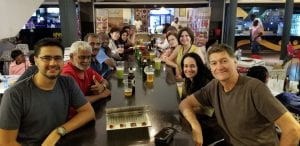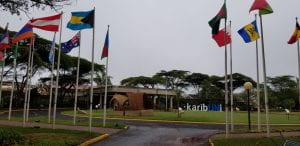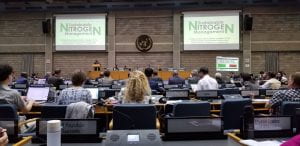On Sunday evening, before the general INMS meeting began, a group from the Kisumu field trip plus several others got together for dinner and a beer. Very interesting and inspiring to be sitting around a table with scientists from five continents: Asia, Africa, Europe, N. America, and S. America. We were only missing the Aussies! Clockwise from left: Felipe Pacheco (Brazil), N. Raghuram (India), Tapan Adhya (India), Cargele Masso (Cameroon), Azusa Oita (Japan), two whom I don’t know, Mark Sutton (INMS Project Lead, UK), one hidden, Xiaoyuan Yan (China), Sergiy Medinets (Ukraine), Oksana Butrym (Ukraine), Kateryna Utkina (Ukraine), Camille Nolasco (Brazil), and Jean Ometto (Brazil).
Our meeting was held at the United Nations headquarters in Nairobi. Maybe I’m a bit of a sap, but I found it inspiring to approach our meeting each day through the walkway bordered by the flags of all the member countries. After passing through really intensive security and showing ID badges, that is.
The front of the UN meeting building. The sign, “karibUNi”, has a nice play on words. “Karibu” is Swahili for “thank you”; then, of course, there’s the blue “UN”, and “UNi” is French for “united”.
We had our plenary sessions in the main meeting room, complete with alphabetical country signs and individual microphones. The first day of the meeting included an overview of the INMS goals and progress for the UN Environment Programme Permanent Representatives from many of the countries. Several of those representatives also spoke, addressing the progress of and challenges facing their respective countries for sustainable nitrogen management. One of the most touching came from the representative from Sri Lanka, who touched on their environmental issues, but also the tragedy of the recent, horrific Easter bombings in that country. The U.S. representative H.E. (Her Excellency) Ms. Lori Dando spoke predominantly about the U.S. commitment to nitrogen management as exemplified by various activities of the U.S. Environmental Protection Agency.

One of the important recent accomplishments by Mark Sutton and INMS was to work with UNEP to pass a resolution addressing sustainable nitrogen management (see resolution L.16) at the Fourth UN Environment Assembly (UNEA-4). Currently, nitrogen issues are addressed in several diverse UNEP programs and policy platforms, including, for example:
- climate change (N2O is a potent greenhouse gas);
- biodiversity (N deposition and runoff are key causes of biodiversity loss in both terrestrial and aquatic ecosystems);
- sustainable development goals (N fertilizer is essential for agricultural productivity; excess N in many countries causes the problems just mentioned, but insufficient N in many regions with developing economies hinders crop production. The key is getting the balance right).
But none of these other platforms address N management in a coherent way. The UNEA-4 Nitrogen Management Resolution proposes, not yet another policy platform, but instead an coordinating body to help integrate nitrogen issues across all the existing platforms.
Throughout the rest of the meeting, we provided updates on our various efforts in different components of INMS, and had discussions to coordinate activities between those components.
Work hard and have fun. Mark Sutton and Emily Baker (both at Univ. of Edinburgh) lead a round of Celtic dancing after the meeting dinner on Tues. April 30.
Daniel Ddiba (Stockholm Environment Institute) leads an enthusiastic group (including me) in an African pop dance.
By Wednesday, I needed to escape hotels and meeting rooms, so Jean Ometto and I took an early morning run to the nearby Karura Forest Reserve – right within the city of Nairobi. After running past heavily guarded embassies and the UN compound, we entered a much more natural world – greeted at sunrise by crowned cranes hanging out on the soccer field by one of the Forest entrances.
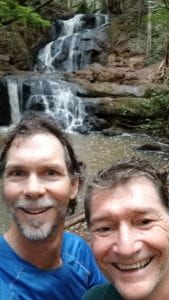 Jean and I by the waterfall in the Forest Reserve.
Jean and I by the waterfall in the Forest Reserve. 
The so-called Mau-Mau caves, in which fighters from Kenya’s quest for independence (the Mau-mau Rebellion) hid during the 1950’s. Now, this is a nesting site for a small population of bats.
 There are still some large native trees in this relatively intact section of riparian forest. Other parts of the Karura Forest Reserve are dominated by forestry plantations (e.g., Eucalyptus species).
There are still some large native trees in this relatively intact section of riparian forest. Other parts of the Karura Forest Reserve are dominated by forestry plantations (e.g., Eucalyptus species).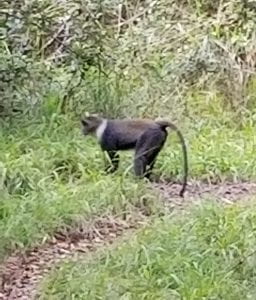 I’m not used to seeing monkeys on my morning runs.
I’m not used to seeing monkeys on my morning runs.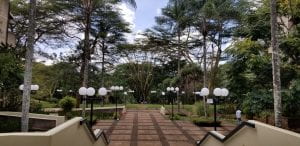
The grounds at the UN complex provided good respite from meeting rooms, and to get a quick walk to stretch my legs after lunch.
More monkeys, here scaling the UN complex walls.
Participants at INMS-4, after conclusion of a successful meeting.
